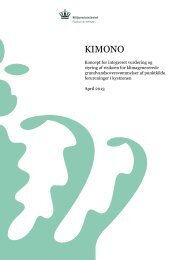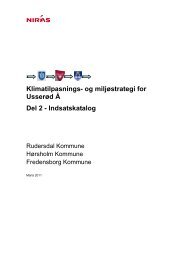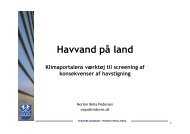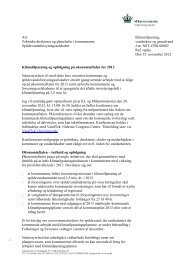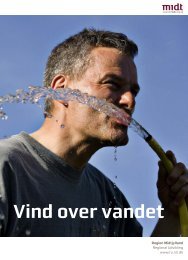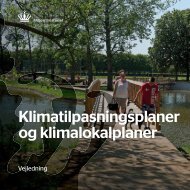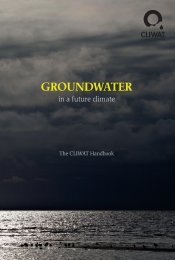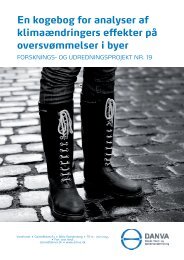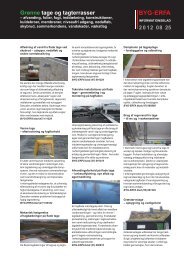Mapping climate change - barriers and opportunities for action
Mapping climate change - barriers and opportunities for action
Mapping climate change - barriers and opportunities for action
Create successful ePaper yourself
Turn your PDF publications into a flip-book with our unique Google optimized e-Paper software.
Urban renewal <strong>and</strong> <strong>climate</strong> <strong>change</strong> adaptation<br />
In some situations, <strong>climate</strong> <strong>change</strong> adaptation affects more than just the individual building. In such<br />
situations concerted ef<strong>for</strong>ts may be difficult to coordinate, e.g. in housing areas with many different<br />
owners <strong>and</strong>/or many smaller properties/detached houses. Here, by application of the Urban Renewal<br />
Act, the municipality can play the role of initiator <strong>and</strong> coordinator:<br />
Urban renewal of Kulturringen, an urban area in Høje-Taastrup Municipality near Copenhagen, has<br />
received funding under the Urban Renewal Act. The project is a public-private partnership managed by<br />
the municipality <strong>and</strong> with participation from property owners, enterprises, cultural institutions, schools<br />
<strong>and</strong> housing associations in the area. The overall project includes a sub-project which stems from a<br />
need <strong>for</strong> <strong>climate</strong> <strong>change</strong> adaptation. In order to prevent future flooding, the area's retention basin had to<br />
be extended. The project chose to establish a "blue park"; a recreational area which also serves as a<br />
connection between two parts of the city.<br />
The legislative framework <strong>for</strong> the social housing sector includes extensive requirements <strong>for</strong><br />
systematic property management of social housing, including requirements <strong>for</strong> long-term<br />
operational <strong>and</strong> maintenance planning. Most recently, requirements have been introduced <strong>for</strong> the<br />
digitisation of property management <strong>and</strong> maintenance based on a newly developed administrative<br />
classification system. The municipalities <strong>and</strong> the social housing organisations are responsible <strong>for</strong><br />
realising at local level the requirements that have been stipulated at central level. If they deem it<br />
relevant, the municipalities <strong>and</strong> the social housing organisations could include <strong>climate</strong> <strong>change</strong><br />
adaptation as an integral part of their management dialogue.<br />
The Danish Building Defects Fund <strong>for</strong> social housing, which has per<strong>for</strong>med inspections of<br />
buildings classified as social housing since 1986, has collected considerable knowledge about the<br />
problems relating to building design <strong>and</strong> building materials. The Fund makes its experience<br />
available to others, including experience related to <strong>climate</strong> <strong>change</strong> vulnerability <strong>and</strong> adaptation;<br />
experience which could be relevant <strong>for</strong> players in other housing sectors. The area covered by the<br />
Danish Building Defects Fund was exp<strong>and</strong>ed in 2011 to include large renovation projects in the<br />
existing social housing stock.<br />
Digital records on buildings, topography <strong>and</strong> <strong>climate</strong> are plentiful. The Ministry of Housing, Urban<br />
<strong>and</strong> Rural Affairs has launched work to link <strong>climate</strong> data with data on public rental properties in<br />
registers such as the Danish Building <strong>and</strong> Housing Register <strong>and</strong> the Ministry's own social <strong>and</strong><br />
public housing registers. Topographic data from the Danish Elevation Model are linked to<br />
in<strong>for</strong>mation in the Danish Building <strong>and</strong> Housing Register about the location of buildings.<br />
Furthermore, the proportion of social housing with basements in the individual municipalities has<br />
been mapped. The aim is to enable the use of <strong>climate</strong> data digitally in connection with management<br />
<strong>and</strong> renovation of properties <strong>and</strong> planning new building etc. The greater focus on digitisation of<br />
property management, see the above, will very likely be able to support this.<br />
In recent years the Ministry of Housing, Urban <strong>and</strong> Rural Affairs has developed economic models<br />
<strong>for</strong> use when contemplating renovation projects with long life spans, e.g. energy savings or <strong>climate</strong><br />
<strong>change</strong> adaptation in social housing, including building new low-energy housing. These models can<br />
relatively easily be adapted <strong>for</strong> use when investing in existing buildings, also outside the social<br />
housing sector.<br />
27




